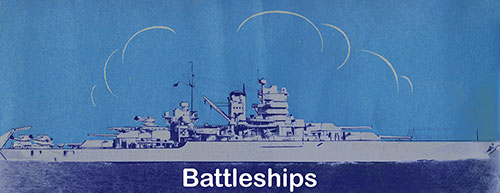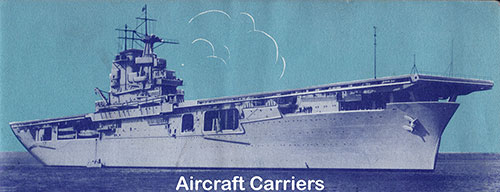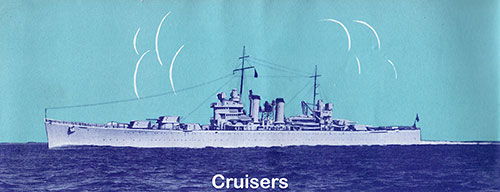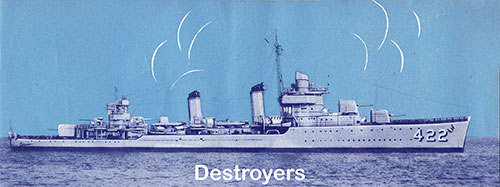The Battle Force - Our Navy in WW2 - 1945
The Battleship remains the backbone of the Fleet. The floating airport is logically called an Aircraft Carrier. Many light and heavy Cruisers and Destroyers are torpedo carriers, gun carriers, and depth charge carriers.
BATTLESHIPS

Battleships. Our Navy, 1945. GGA Image ID # 1d66662c9e
Despite the tendency of some critics to discount the value of the Battleship because of the increasing strength of Aviation, the Battleship still remains the backbone of the Fleet.
It is large, heavily armored, mounts the heaviest guns—and has great offensive and defensive strength. It can be sunk, but is designed to withstand repeated hits by shells, bombs, torpedoes and mines.
The Battleship is a floating city—a home of 1,500 men—with facilities for feeding, sleeping and taking care of them for long periods of time while the ship is absent from its base.
The United States Navy has sixteen Battleships, including the "North Carolina," which was commissioned early in 1941 — the first Battleship to join our fleet since the "West Virginia," "Colorado" and "Maryland" were completed between 1921 and 1923. Also to be commissioned in 1941 is the "Washington." Fifteen additional Battleships have been contracted for, although work has not actually been started on all of them.
These new modern Battleships will cost more than $70,000,000 each and will have a speed in excess of the top speed of about 22 knots made by the fastest of our older Battleships. Four or more Airplanes will be carried, for scouting purposes.
The nine or more 16-inch guns which each ship mounts will have a range in excess of 15 miles. The ships will be heavily armored, with several protective decks, one above the other—and with heavy side armor.
They will be divided into many watertight compartments. like a honeycomb, so that if one is flooded, the ship will not sink.
When completed in 1946, our Fleet of 32 Battleships, will be the largest and most powerful battle force ever to sail the high seas.
AIRCRAFT CARRIERS

Aircraft Carriers. Our Navy, 1945. GGA Image ID # 1d668753e7
The increasing importance of Aircraft as an offensive weapon has led to the development of a floating airport, logically called an Aircraft Carrier.
These fast, long range ships, operating with the Fleet, serve as a protection to our Battleships by their ability to swiftly launch planes to engage enemy planes and ships, and to scout and bomb at long distances from the fleet itself.
In a fleet action the Aircraft Carrier remains far behind the actual line of battle—perhaps 30 to 100 miles away, out of sight, over the horizon.
The main weapon, and only reason for a Carrier, is its swarm of planes. All its guns are of small caliber and are intended for defensive purposes only. Aircraft Carriers must be speedy, so they are lightly armored and are vulnerable to shell hits, bomb hits, or torpedoes.
Their main defense is their speed, and their brood of fighting planes which keep enemy planes and ships at a distance. Generally, Aircraft Carriers are accompanied by a screen of Destroyers or Cruisers to guard them against torpedo attack.
We have six Carriers in active service—with twelve more to be completed before 1946. These ships carry crews of from 1.400 to 1,900 men. Their normal complement is 75 to 100 Planes, plus some 25 to 50 per cent reserves, carried partially dismantled.
These planes can clear the ship in from 18 to 30 minutes. Landings are somewhat slower. As the planes hit the broad deck, hooks, which are lowered from the plane, catch on wires strung across the deck, and the plane is brought to a quick stop —then lowered by elevators down into the great hangers inside the ship.
CRUISERS

Cruisers. Our Navy, 1945. GGA Image ID # 1d66e87231
An efficient fleet must have a great number of light and heavy Cruisers. With less armor and striking power than the Battleship, but with speed and guns to ward off fast vessels of the enemy, the Cruiser's value is inestimable.
In the United States Navy the Light Cruisers (less than 10,000 tons displacement and armed with 6-inch main batteries) are the scouts of the fleet. They have a long cruising radius and high speed of about 32 to 35 knots.
They are the largest vessels of the fleet which carry torpedoes, and hence can be used to attack enemy battleships. They also act as commerce destroyers and in protecting our own shipping. There are 19 Light Cruisers in service, with 40 more being built or contracted for.
The Heavy Cruisers are vessels of 10,000 tons displacement, long cruising radius, high speed, and equipped with 8-inch guns. We have 18 such ships in service, with 14 more contracted for. These new Cruisers, now building, will be radically new in design, and of tremendous tonnage and gun power—so big, in fact, they will be really Battle-Cruisers, or "first-cousins" to a Battleship.
Our Cruisers are essential both for fleet action and for independent operations. When with the fleet they act as a screen or protective force for the main body—they also act as scouts to discover the enemy's whereabouts. They are also excellent for repulsing enemy destroyer attack.
For independent operations, our Cruisers can be used with Aircraft Carriers, or alone, for preying on enemy commerce, for patrol, or as escorts for our own merchant vessels.
They are the Navy's general utility ship—with lots of speed —great gun power—and tremendous fighting capacity.
DESTROYERS

Destroyers. Our Navy, 1945. GGA Image ID # 1d6787248e
The Destroyer is perhaps the most useful of all our smaller vessels. Destroyers are torpedo carriers and gun carriers, as well as depth charge carriers. They are equipped to hunt submarines, or to launch a torpedo attack, to escort a convoy, patrol the seas, or to harass enemy commerce.
Possessed of high speed, maneuverability, and gun and torpedo power, it can rush in on an opposing fleet and break up its effectiveness of fire through well directed torpedo attack. With its depth charges it can destroy enemy submarines. Because of its great volume of anti-aircraft fire it can throw a protective screen of metal around the heavier vessels of the fleet, or afford similar protection to ships in a convoy.
Destroyers are unarmored and so are dependent on their high speed and their maneuverability, for their safety. They are equipped with torpedoes, which cost approximately $12,000 each, and guns of 5-inch or less. Destroyers cost $8,000,000 or more, and carry crews of 100 to 200 men, depending on their class.
Destroyers, like all other modern men-of-war have protective armor against attacks by enemy aircraft. The 5-inch guns can be elevated to shoot at aerial targets, as well as surface targets. These guns are backed with a considerable battery of heavy machine guns, and the upper deck is armor plated to deflect machine gun bullets fired from attacking planes.
We now have 159 Destroyers, many of them old ships from World War days—but there are 204 new ones of modern design building. Seventeen will be completed in 1941—forty-five in 1942—eighty-six in 1943—fifty-two in 1944 and four in 1945.
When completed, our Destroyer fleet will total 363—far superior in number to the destroyers in service by any other nation.
